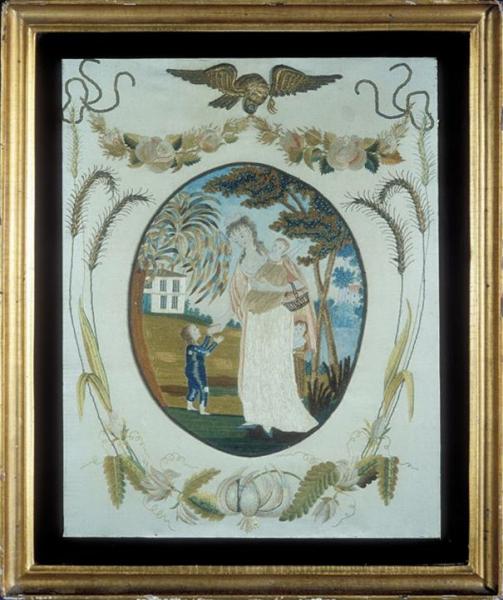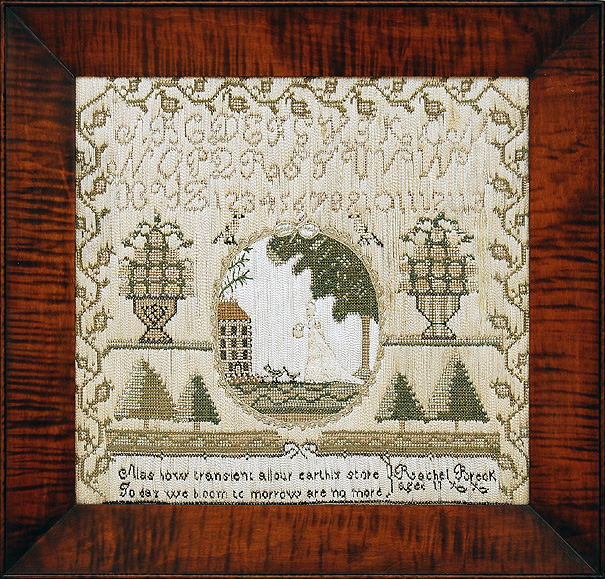In the fall of 2011, an outstanding, fully-worked sampler made by Rachel Breck, age 11, circa 1803 came to light. Its very close relationship to others made by girls from Northampton, Massachusetts was immediately evident; specifically one published in Mary Jaene Edmond’s Samplers & Samplermakers An American Schoolgirl Art 1700-1850 (by Bathsheba Copeland, dated 1805, figure 15). The Breck sampler had been just outside of Philadelphia, owned privately by the niece of a highly regarded dealer of books and manuscripts, Richard Wormser. His niece inherited the sampler upon his death in 1975. When we researched further on behalf of the owner, we realized that Rachel Breck’s needlework skills were already known to many in the field. An article by Betty Ring, “New England Heraldic Needlework of the Neoclassical Period,” (The Magazine Antiques, October, 1993) illustrates an excellent silk embroidery entitled, “Charity,” worked by the same Rachel Breck. This has been in the collection of the National Museum of American History since 1951 when it was donated by collectors. Happily, Rachel’s sampler is now in the same museum and it helps us all to know more about the precise date of “Charity,” which has long been a bit cloudy, in that two different years are part of family notations on the backboard of the frame: 1803 and 1810. It can now be assumed that the sampler was made in 1803 and the silk embroidery in 1810. We are pleased to feature the article below that appeared in “O Say Can You See,” the blog for the Smithsonian’s museum site, written by museum volunteer and researcher, Sheryl De Jong, who was instrumental in reuniting these two important pieces.
A mystery solved in the textile collection
The Textile Collection at the National Museum of American History contains an embroidered picture of Charity based on a mezzotint engraving by P. Stampa. It was embroidered by Rachel Breck who was born July 22, 1792, to Joseph Hunt (1766-1801) and Abigail Kingsley (c1766 – 1846) Breck of Northampton, Massachusetts.

“Charity,” stitched by Rachel Breck, 22 in x 18 in, TE*E388172, Image No. 81-5200
On the backboard of the frame is an inscription hand-written in ink: “Worked by Rachel Breck Hooker in 1810 in the 18th year of her age.” The date is then amended to 1803 and the age to 11, in pencil. The liner is backed with grey rag paper bearing the ink inscription: “Wrought by Mrs. Rachel Breck Hooker in 1810, the 18th year of her age.”
The mystery behind the two possible dates was recently solved when the museum acquired a sampler made by Rachel Breck at age 11. Her sampler is nearly identical to ones by Bathsheba Copeland and Emily Parsons, also from Northampton, Massachusetts. The uniqueness of these samplers is the long satin stitches completely covering the background.

Rachel Breck’s sampler, 12 ¾ in x 13 ¾ in. Catalogue No. 2011.0256.01, Image No. AHB2012q00302
It was not uncommon for a young girl to make a sampler and then go on to make a more difficult silk embroidered picture. Rachel probably began her education in Northampton, where she made her sampler. She went on to receive more schooling at the Deerfield Academy in Deerfield, Massachusetts, approximately 17 miles north of Northampton. She attended three 12-week sessions beginning April 11, 1806. It is not known if she completed any needlework while at the Academy.
Her silk embroidered picture is nearly identical to one embroidered by Sarah Marshall now in the collection of the DAR Museum, that came with the information that it was stitched at the Misses Patten school in Hartford, Connecticut. Presumably her parents wanted to further her education and sent her at the age of 18 to attend school inHartford. A wide range of subjects were taught at the Misses Patten’s School; the curriculum included “Latin, Greek, English, & French languages, grammatically – mercantile and common arithmetic – book-keeping – geography, with the use of globes and maps – lectures in astronomy and natural philosophy, writing, composition, drawing, painting, embroidery filligre [sic] & other ornamental work.”
In 1819 Rachel married George Hooker who was born in 1798 to John and Sarah (Dwight) Hooker of Northampton. He went to Yale, class of 1814, and was a physician who resided in Longmeadow, Massachusetts. They had eight children born between 1820 and 1833. Rachel died in 1879.
It is not known when her embroideries were separated, but her silk embroidered piece was purchased by collectors Dr. and Mrs. Arthur Greenwood who donated it to theUnited Sates National Museumin 1951. Her sampler was purchased by collector Richard Wormser (1898-1975) and recently acquired by the museum.
The two comprise the first example in the Textile Collection of a young girl’s earlier sampler and her later more technically advanced silk embroidery. Rachel Breck’s embroideries have once again been reunited.
There are 137 American samplers in the Textile Collection. The first was donated in 1886, the Margaret Dinsmoor sampler. The earliest dated sampler in the collection was made in 1735 by Lydia Dickman of Boston, Massachusetts. 51 samplers from the collection can be seen on our website. Watch for more to be added in the near future.
Sheryl De Jong is a volunteer in the Division of Home and Community Life’s Textile Collection at the National Museum of American History.

